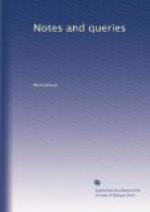O’Halloran, however, in his History of Ireland, favours us with another definition; upon the value of which I should be glad of the opinion of some of your learned contributors. Speaking of Lughaidh, he says:—
“From this prince the
month of August was called Lughnas
(Lunas), from which the English
adopted the name Lammas, for
the 1st day of August.”
J. SANSOM.
Mother Grey’s Apples.—At the time I was a little girl,—you will not, I am sure, be ungallant enough to inquire when that was, when I tell you I am now a woman,—I remember that the nursery maid, whose duty it was to wait upon myself and sisters, invariably said, if she found us out of temper—“So, so! young ladies, you are in the sulks, eh? Well, sulk away; you’ll be like ‘Mother Grey’s apples,’ you’ll be sure to come round again.” We often inquired, on the return of fine weather, who Mother Grey was, and what were the peculiar circumstances of the apples coming round?—questions, however, which were always evaded. Now, as the servant was a Cambridge girl, and had a brother a gyp, or bedmaker, at one of the colleges, besides her uncle keeping the tennis court there, I have often thought there must have been some college legend or tradition in Alma Mater, of Mother Grey and her apples. Will any of your learned correspondents, should it happen to fall within their knowledge, take pity on the natural curiosity of the sex, by furnishing its details?
A.M.
Jewish Music.—What was the precise character of the Jewish music, both before and after David? And what variety of musical instruments had the Jews?
J. SANSOM
The Plant “Haemony.”—Can any of your readers furnish information of, or reference to the plant Haemony, mentioned in Milton’s Comus, l. 638.:—
“—a small unsightly root, But of divine effect,... The leaf was darkish, and had prickles on it, But in another country, as he said, Bore a bright golden flower, but not in this soil: —More medicinal is it than that Moly, That Hermes once to wise Ulysses gave; He called it Haemony, and gave it me, And bade me keep it as of sov’reign use ’Gainst all enchantments,” &c. &c.
The Moly that Hermes to Ulysses gave, is the wild garlick, [Greek: molu] by some thought the wild rue. (Odyss. b. x. 1. 302.) It is the [Greek: moluza] of Hippocrates, who recommends it to be eaten as an antidote against drunkenness. But of Haemony I have been unable to find any reference among our ordinary medical authorities, Paulus Aeginata, Celsus, Galen, or Dioscorides. A short note of reference would be very instructive to many of the readers of Milton.
J.M. BASHAM.
17. Chester Street, Belgrave Square.
Ventriloquism.—What evidence is there, that ventriloquism was made use of in the ancient oracles? Was the [Greek: pneuma puthonos] (Acts, xvi. 16.) an example of the exercise of this art? Was the Witch of Endor a ventriloquist? or what is meant by the word [Greek: eggastrimuthos] at Isai. xix. 3., in the Septuagint?




